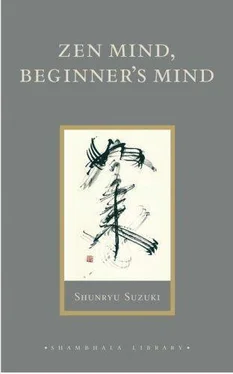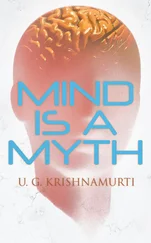“The point we emphasize is strong confidence in our original nature.”
The purpose of my talk is not to give you some intellectual understanding, but just to express my appreciation of our Zen practice. To be able to sit with you in zazen is very, very unusual. Of course, whatever we do is unusual, because our life itself is so unusual. Buddha said, “To appreciate your human life is as rare as soil on your fingernail.” You know, dirt hardly ever sticks on your nail. Our human life is rare and wonderful; when I sit I want to remain sitting forever, but I encourage myself to have another practice, for instance to recite the sutra, or to bow. And when I bow, I think, “This is wonderful.” But I have to change my practice again to recite the sutra. So the purpose of my talk is to express my appreciation, that is all. Our way is not to sit to acquire something; it is to express our true nature. That is our practice.
If you want to express yourself, your true nature, there should be some natural and appropriate way of expression. Even swaying right and left as you sit down or get up from zazen is an expression of yourself. It is not preparation for practice, or relaxation after practice; it is part of the practice. So we should not do it as if it were preparing for something else. This should be true in your everyday life. To cook, or to fix some food, is not preparation, according to Dogen; it is practice. To cook is not just to prepare food for someone or for yourself; it is to express your sincerity. So when you cook you should express yourself in your activity in the kitchen. You should allow yourself plenty of time; you should work on it with nothing in your mind, and without expecting anything. You should just cook! That is also an expression of our sincerity, a part of our practice. It is necessary to sit in zazen, in this way, but sitting is not our only way. Whatever you do, it should be an expression of the same deep activity. We should appreciate what we are doing. There is no preparation for something else.
The Bodhisattva’s way is called “the single-minded way,” or “one railway track thousands of miles long.” The railway track is always the same. If it were to become wider or narrower, it would be disastrous. Wherever you go, the railway track is always the same. That is the Bodhisattva’s way. So even if the sun were to rise from the west, the Bodhisattva has only one way. His way is in each moment to express his nature and his sincerity.
We say railway track, but actually there is no such thing. Sincerity itself is the railway track. The sights we see from the train will change, but we are always running on the same track. And there is no beginning or end to the track: beginningless and endless track. There is no starting point nor goal, nothing to attain. Just to run on the track is our way. This is the nature of our Zen practice.
But when you become curious about the railway track, danger is there. You should not see the railway track. If you look at the track you will become dizzy. Just appreciate the sights you see from the train. That is our way. There is no need for the passengers to be curious about the track. Someone will take care of it; Buddha will take care of it. But sometimes we try to explain the railway track because we become curious if something is always the same. We wonder, “How is it possible for the Bodhisattva always to be the same? What is his secret?” But there is no secret. Everyone has the same nature as the railway track.
There were two good friends, Chokei and Hofuku. They were talking about the Bodhisattva’s way, and Chokei said, “Even if the arhat (an enlightened one) were to have evil desires, still the Tathagata (Buddha) does not have two kinds of words. I say that the Tathagata has words, but no dualistic words.” Hofuku said, “Even though you say so, your comment is not perfect.” Chokei asked, “What is your understanding of the Tathagata’s words?” Hofuku said, “We have had enough discussion, so let’s have a cup of tea!” Hofuku did not give his friend an answer, because it is impossible to give a verbal interpretation of our way. Nevertheless, as a part of their practice these two good friends discussed the Bodhisattva’s way, even though they did not expect to find a new interpretation. So Hofuku answered, “Our discussion is over. Let’s have a cup of tea!”
That is a very good answer, isn’t it? It is the same for my talk-when my talk is over, your listening is over. There is no need to remember what I say; there is no need to understand what I say. You understand; you have full understanding within yourself. There is no problem.
The Indian thought and practice encountered by Buddha was based on an idea of human beings as a combination of spiritual and physical elements. They thought that the physical side of man bound the spiritual side, and so their religious practice was aimed at making the physical element weaker in order to free and strengthen the spirit. Thus the practice Buddha found in India emphasized asceticism. But Buddha found when he practiced asceticism that there was no limit to the attempt to purge ourselves physically, and that it made religious practice very idealistic. This kind of war with our body can only end when we die. But according to this Indian thought, we will return in another life, and another life, to repeat the struggle over and over again, without ever attaining perfect enlightenment. And even if you think you can make your physical strength weak enough to free your spiritual power, it will only work as long as you continue your ascetic practice. If you resume your everyday life you will have to strengthen your body, but then you will have to weaken it again to regain your spiritual power. And then you will have to repeat this process over and over again. This may be too great a simplification of the Indian practice encountered by Buddha, and we may laugh at it, but actually some people continue this practice even today. Sometimes without realizing it, this idea of asceticism is in the back of their minds. But practicing in this way will not result in any progress.
Buddha’s way was quite different. At first he studied the Hindu practice of his time and area, and he practiced asceticism. But Buddha was not interested in the elements comprising human beings, nor in metaphysical theories of existence. He was more concerned about how he himself existed in this moment. That was his point. Bread is made from flour. How flour becomes bread when put in the oven was for Buddha the most important thing. How we become enlightened was his main interest. The enlightened person is some perfect, desirable character, for himself and for others. Buddha wanted to find out how human beings develop this ideal character-how various sages in the past became sages. In order to find out how dough became perfect bread, he made it over and over again, until he became quite successful. That was his practice.
But we may find it not so interesting to cook the same thing over and over again every day. It is rather tedious, you may say. If you lose the spirit of repetition it will become quite difficult, but it will not be difficult if you are full of strength and vitality. Anyway, we cannot keep still; we have to do something. So if you do something, you should be very observant, and careful, and alert. Our way is to put the dough in the oven and watch it carefully. Once you know how the dough becomes bread, you will understand enlightenment. So how this physical body becomes a sage is our main interest. We are not so concerned about what flour is, or what dough is, or what a sage is. A sage is a sage. Metaphysical explanations of human nature are not the point. So the kind of practice we stress thus cannot become too idealistic. If an artist becomes too idealistic, he will commit suicide, because between his ideal and his actual ability there is a great gap. Because there is no bridge long enough to go across the gap, he will begin to despair. That is the usual spiritual way. But our spiritual way is not so idealistic. In some sense we should be idealistic; at least we should be interested in making bread which tastes and looks good! Actual practice is repeating over and over again until you find out how to become bread. There is no secret in our way. Just to practice zazen and put ourselves into the oven is our way.
Читать дальше


![Джон Харгрейв - Mind Hacking [How to Change Your Mind for Good in 21 Days]](/books/404192/dzhon-hargrejv-mind-hacking-how-to-change-your-min-thumb.webp)








